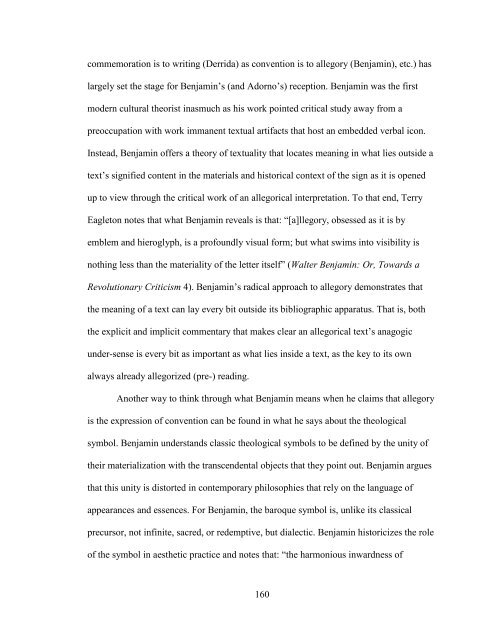TABOO: THE ACTUAL MODERNIST AESTHETIC, MADE REAL A ...
TABOO: THE ACTUAL MODERNIST AESTHETIC, MADE REAL A ...
TABOO: THE ACTUAL MODERNIST AESTHETIC, MADE REAL A ...
Create successful ePaper yourself
Turn your PDF publications into a flip-book with our unique Google optimized e-Paper software.
commemoration is to writing (Derrida) as convention is to allegory (Benjamin), etc.) has<br />
largely set the stage for Benjamin‟s (and Adorno‟s) reception. Benjamin was the first<br />
modern cultural theorist inasmuch as his work pointed critical study away from a<br />
preoccupation with work immanent textual artifacts that host an embedded verbal icon.<br />
Instead, Benjamin offers a theory of textuality that locates meaning in what lies outside a<br />
text‟s signified content in the materials and historical context of the sign as it is opened<br />
up to view through the critical work of an allegorical interpretation. To that end, Terry<br />
Eagleton notes that what Benjamin reveals is that: “[a]llegory, obsessed as it is by<br />
emblem and hieroglyph, is a profoundly visual form; but what swims into visibility is<br />
nothing less than the materiality of the letter itself” (Walter Benjamin: Or, Towards a<br />
Revolutionary Criticism 4). Benjamin‟s radical approach to allegory demonstrates that<br />
the meaning of a text can lay every bit outside its bibliographic apparatus. That is, both<br />
the explicit and implicit commentary that makes clear an allegorical text‟s anagogic<br />
under-sense is every bit as important as what lies inside a text, as the key to its own<br />
always already allegorized (pre-) reading.<br />
Another way to think through what Benjamin means when he claims that allegory<br />
is the expression of convention can be found in what he says about the theological<br />
symbol. Benjamin understands classic theological symbols to be defined by the unity of<br />
their materialization with the transcendental objects that they point out. Benjamin argues<br />
that this unity is distorted in contemporary philosophies that rely on the language of<br />
appearances and essences. For Benjamin, the baroque symbol is, unlike its classical<br />
precursor, not infinite, sacred, or redemptive, but dialectic. Benjamin historicizes the role<br />
of the symbol in aesthetic practice and notes that: “the harmonious inwardness of<br />
160
















